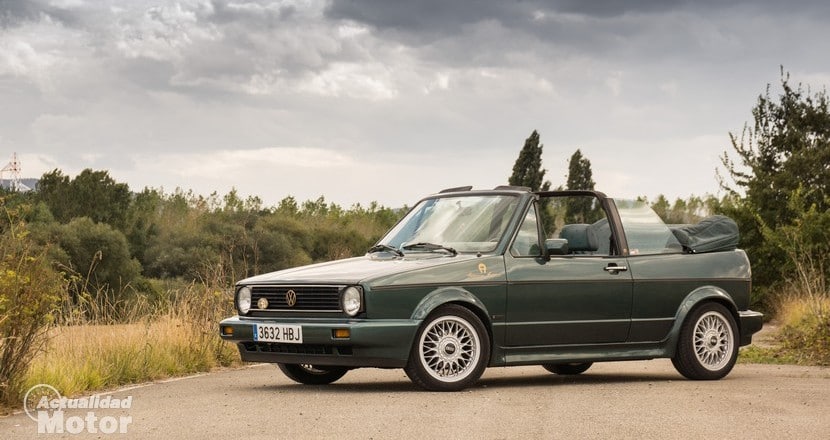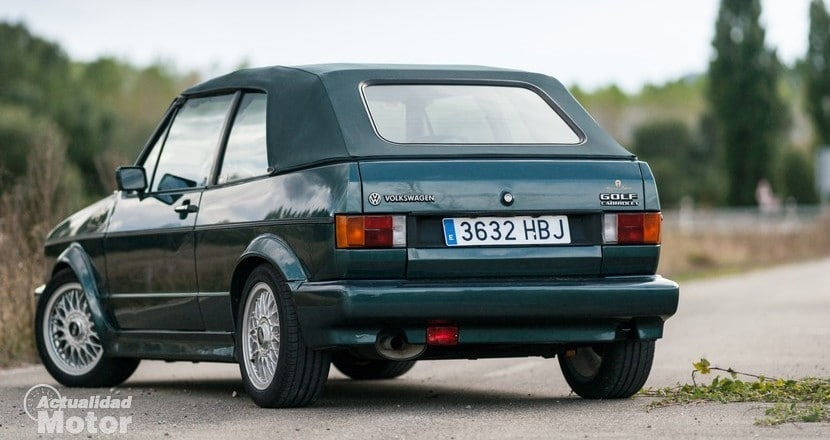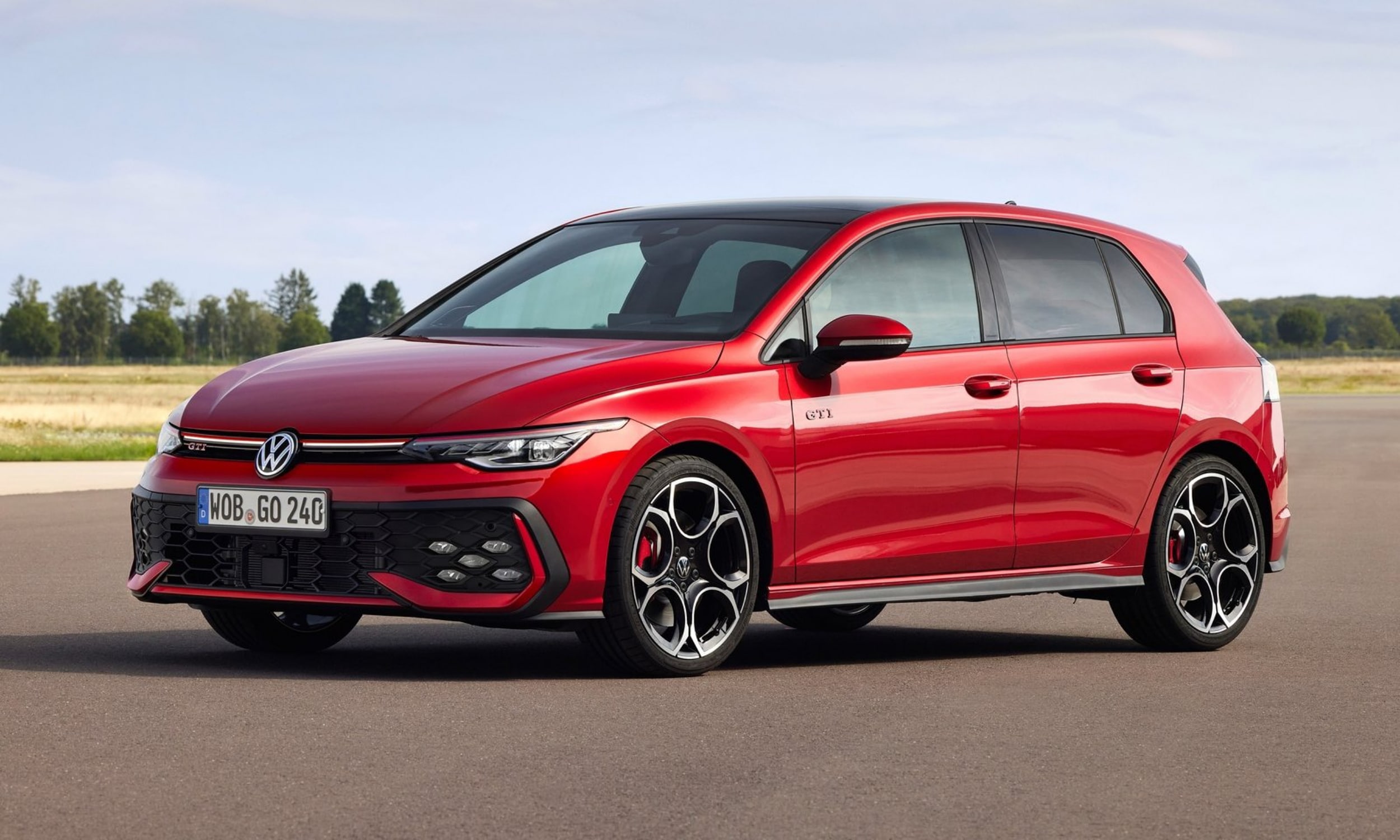
Not every day a manufacturer can celebrate 40 years since the launch of a model, but much less celebrate it in style when there have been four decades of success that have made said model become the benchmark in the segment. The Volkswagen Golf it is an icon, of several generations as well, and it is the car with which all manufacturers compare themselves, the rival to beat. Since its launch in 1974, the Golf has been a leader, avant-garde at times and has known how to reinvent itself.
And although we can criticize things such as the continuity of the latest generations, it is undeniable that the Golf is a car with history and in ActualidadMotor We wanted to pay homage to him by looking at the past. Leaving our usual trend of modern vehicle tests, we bring you in this way the first retrotest, where the protagonist is the Volkswagen Golf Convertible MKI, the first generation with the sky as a roof and one of the most memorable convertible models in the saga.

To put ourselves in a situation, we are going to carefully analyze this week's guest. It's a Golf Cabrio first generation, but we are facing a model of the year 1990, already with the restyling that the compact convertible underwent to resemble the Golf MKII more and sporting a more modern appearance. One generation of the Cabriolet lasts two closed ones, so this convertible that was launched in 1979 was discontinued in 1993 with the arrival of the Golf MKIII.
Our protagonist is equipped with a peculiar engine. While the most famous of this model is the 1.8 DX with mechanical injection and 112 hp (that of the contemporary GTIs), the guest of the week equips the 1.8 2H engine, with electronic injection and catalyst that delivers 98 hp of power It was the last engine to join the model range and one of the most efficient. Despite the years of the model itself, the multipoint electronic injection and the fairly modern catalyst. The benefits on paper are not bad, since these 98CV and 143Nm of torque allowed a 0-100 of 11 seconds and a maximum speed of 166km/h.
For more signs this unit is a special edition named Etienne Aigner, launched in 1990 in collaboration with the designer of the same name, of Hungarian origin, well known in Paris and New York. In Europe, 1491 units of this series were sold. It was offered in three metallic colors: Blue (779 Units), Green (359 Units) and Red (353 Units). As main characteristics, all Etienne Aigners, in addition to the specific color, had rims, the designer's logos and an interior with an exclusive design to match the exterior, as well as the hood and hood cover.
This particular unit is 90 year, imported to Spain from Germany in 1996 and currently has 135.000 on the scoreboard. The car is in a good state of conservation, maintaining the original upholstery and the specific hood cover, although the sun has taken its toll. BBS rims are not original of the model, nor is the wooden steering wheel, the single headlight grille or the lowered suspension.

On an aesthetic level, the car is unmistakable, the front has that Golf identity, either with two or four eyes, and it is easily recognizable. The side view retains the basic design of a closed Golf when the top is down, but if we open it it becomes a small four-seater convertible, although there is the security arch, which has earned the car several taunts when compared to a basket of fruit. While many may think that this model is a Golf MKII, the truth is that the small rear lights are the ones that reveal its origin, it is an MKI, without a doubt.
Inside we find a very simple car. Disgraceful for what it cost at the time. It is noted that it dates from the year 79 and all the controls and buttons are concentrated around the clock panel, with complete information, especially by the MFA on-board computer that marks consumption, distance, average speed and even oil temperature. It is the most modern of this car. The radio and heating controls are located in the central area of the console, next to the ashtray. Depending on the models, the electric windows, the electric hood, the air conditioning and other basic elements today were optional. The only extra of this unit is the power steering.

Despite the small dimensions of the car, habitability is good. The front seats are spacious, with seats that allow longitudinal and height adjustment, although the steering column is fixed. We will caress that yes the knee of the co-driver when putting fifth. The seats collect the body very well. Behind two occupants will have enough space, the Golf Cabriolet is approved for four seats. The trunk has a good volume given the dimensions, but the tailgate leaves a small and narrow loading mouth.
Shall we start?
As soon as you turn the key in the lock, the 1.800cc engine comes to life. It starts very easily, although when hot and after leaving it stopped for a while it is not like that, because these cars The fuel pressure regulator tends to fail.. The engine is audible, it is not a car that shines for soundproofing and the years do not pass in vain, so we found slight vibrations, even when the engine mounts were new.

At the moment of starting to walk we notice that the clutch is hard and it is very easy to start from a standstill once we get the point. The gears go in smoothly, with a good guidance but with quite long routes, especially for the fifth speed, which is somewhat far from us. The reverse gear is next to the first and just like in the Volkswagen of now, it enters when we press the knob down.
As the kilometers go by we realize how much we like this engine. Although a priori it may not seem like a marvel with its 98CV and 143Nm of torque, the truth is that the engine has amazing bass and together with well staggered and relatively short gearbox developments, we will find that it is an engine very elastic at low turns. Comparing it with the latest atmospheric gasoline cars tested, the recoveries of this Golf are very good and it can withstand a lot of drops in laps. Depending on the circumstances, there is no problem in climbing mountain passes without hardly changing the gear, sometimes it seems automatic. Obviously it is not good to abuse the engine at low rpm due to the efforts and temperatures to which it is subjected, but we know that it responds.

Throughout the rest of the rev range it's fairly linear, with consistent thrust and loudness. in growing. It is when we reach the top of the rev counter when we notice that it begins to faint. The short transmission ratios, the engine and the low weight of the set make it a car very agile in the city.
When it comes to driving at higher speeds, the truth is that we will rarely drive faster than 120 km/h, and not because the car can't. With the hood up from that speed it suddenly appears much more aerodynamic noise, which will be annoying if we drive like this for a long time. With the top off and the windows rolled up the wind won't bother us up to those speeds, as long as we're riding in the front. Riding in the back after leaving the salon is not advisable. To avoid turbulence, a deflector can be placed, which removes a lot of wind and allows us to roll with hardly any discomfort, although we cancel the rear seats.

And when we face winding roads we understand the why the fame of the Golf in terms of dynamics. It is a car that goes on rails and in this case you help the lowered and harder suspensions, with Bilstein shock absorbers and Eibach springs. The car is very firm and poised and responds reactively to steering wheel input. It also allows you to go fast because it is a very neutral car, in which understeer takes a long time to appear. That we are talking about a convertible, which is never the best option to run when having a less rigid bodywork. Rushing too much is not a good idea either, because there are no abbreviations here, neither ABS, nor ESP, nor ESC. Any.
The suspension is an ally on the road, although it can be somewhat tortuous in very bumpy areas, but in the city it is only good when the car is parked. car drives pretty hard and in the speed bumps you have to be careful if you don't want to suffer. We can get to put blows that hurt the soul. It is a circular nuisance around the city trying not to step on sewers or large potholes. Fortunately it is a very narrow car and we can avoid obstacles without leaving the lane.

And although in a car of enjoyment like this it is not the most important thing, let's talk about consumption, because you know that like my colleague Eduardo I am a freak in this regard. It is a very frugal car. What is better than a leisure car that spends less than the daily one? If we trust the MFA on-board computer we will see that on roads or highways we will be around between 7 and 8 liters, being able to reach 6 if we are very calm. In the city, on the other hand, things are not so pretty, and 10 or 11 liters are not impossible. This speaking of data from the computer, which is relatively reliable for the technology it uses and we can calculate increments of around half a liter to get the real consumption.
After the refreshing ride, it's time to park this Golf Convertible MK1 and start thinking about the next retrotest. big time












































hello, I would like to give a little nuance about the video that is published, the golf cabrio was not badly equipped, nothing further, it had electric windows, electrically operated hood, central locking (pneumatic), power steering, air conditioning, and even heating in the seats, this last accessory being not included in the closed golf, it goes without saying that all these luxuries were extras, difficult to find a copy with all the equipment since it was an extraordinarily expensive car for what it was, as an example, The only car as expensive as that in VW was the "carat-santana", with the big difference between the two models.
All the best
Hello good evening, my name is Pedro. I have had a GOLF with these characteristics for many years. Today I have a little abandoned because of the economic crisis. I have always refused to sell it despite the numerous offers I have had and of course I still refuse to sell it. It is red and thanks to the fact that I am currently looking for some parts to restore it completely I have seen your publication. For this reason and because I have never seen one with the same characteristics as mine, I just looked at the car's documentation and I find that the type of car says 155 DX2. I would like to know more about the peculiarities of my car. If anyone can help me I would be very grateful.
Thank you very much.
155 means golf mk1 cabriolet. DX2 means that you have a second generation 1.8 DX engine (they started mounting them back in 1985) one of the differences from the normal DX is that the tappets are hydraulic and do not require valve adjustments, I know that it has more improvements but one of the most remarkable is that, power the same 112cv and of course with kjetronic mechanical injection. Mine is an engine prior to the DX, it is from 1979 and it mounts an EG 1.6 110cv engine also with kjetronic mechanical injection. My advice with these cars is not to leave them standing still for a long time (years). The deposit ends up oxidizing as it is metallic, and rust does not sit well with the injection. It is better to move it a little or add a little, but keep doing it and pouring it every 4 months, even if it is 5 liters of gasoline, to prevent it from degrading and rotting the tank.
All the best